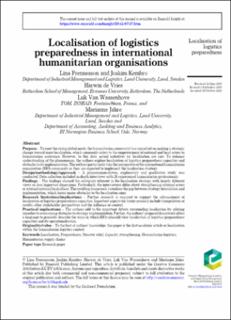| dc.contributor.author | Jahre, Marianne | |
| dc.contributor.author | Frennesson, Lina | |
| dc.contributor.author | Kembro, Joakim | |
| dc.contributor.author | de Vries, Harwin | |
| dc.contributor.author | Van Wassenhove, Luk N. | |
| dc.date.accessioned | 2022-03-17T11:42:41Z | |
| dc.date.available | 2022-03-17T11:42:41Z | |
| dc.date.created | 2021-01-20T16:40:02Z | |
| dc.date.issued | 2020 | |
| dc.identifier.citation | Journal of Humanitarian Logistics and Supply Chain Management. 2020, 11(1), | en_US |
| dc.identifier.issn | 2042-6747 | |
| dc.identifier.uri | https://hdl.handle.net/11250/2985803 | |
| dc.description.abstract | Purpose
To meet the rising global needs, the humanitarian community has signed off on making a strategic change toward more localisation, which commonly refers to the empowerment of national and local actors in humanitarian assistance. However, to this date, actual initiatives for localisation are rare. To enhance understanding of the phenomenon, the authors explore localisation of logistics preparedness capacities and obstacles to its implementation. The authors particularly take the perspective of the international humanitarian organisation (IHO) community as they are expected to implement the localisation strategy.
Design/methodology/approach
A phenomenon-driven, exploratory and qualitative study was conducted. Data collection included in-depth interviews with 28 experienced humanitarian professionals.
Findings
The findings showed the ambiguity inherent in the localisation strategy with largely different views on four important dimensions. Particularly, the interviewees differ about strengthening external actors or internal national/local offices. The resulting framework visualises the gap between strategy formulation and implementation, which forms major obstacles to the localisation aims.
Research limitations/implications
Further research is required to support the advancement of localisation of logistics preparedness capacities. Important aspects for future research include triangulation of results, other stakeholder perspectives and the influence of context.
Practical implications
The authors add to the important debate surrounding localisation by offering remedies to overcoming obstacles to strategy implementation. Further, the authors’ proposed framework offers a language to precisely describe the ways in which IHOs (should) view localisation of logistics preparedness capacities and its operationalisation.
Originality/value
To the best of authors’ knowledge, this paper is the first academic article on localisation within the humanitarian logistics context. | en_US |
| dc.language.iso | eng | en_US |
| dc.publisher | Emerald | en_US |
| dc.rights | Attribution-NonCommercial-NoDerivatives 4.0 Internasjonal | * |
| dc.rights.uri | http://creativecommons.org/licenses/by-nc-nd/4.0/deed.no | * |
| dc.subject | Localisation | en_US |
| dc.subject | Preparedness | en_US |
| dc.subject | Disaster relief | en_US |
| dc.subject | Capacity strengthening | en_US |
| dc.subject | Humanitarian logistics | en_US |
| dc.subject | Humanitarian supply chains | en_US |
| dc.title | Localisation of Logistics Preparedness in International Humanitarian Organisations | en_US |
| dc.type | Journal article | en_US |
| dc.type | Peer reviewed | en_US |
| dc.description.version | publishedVersion | en_US |
| dc.rights.holder | The Authors | en_US |
| dc.source.volume | 11 | en_US |
| dc.source.journal | Journal of Humanitarian Logistics and Supply Chain Management | en_US |
| dc.source.issue | 1 | en_US |
| dc.identifier.doi | 10.1108/JHLSCM-06-2020-0048 | |
| dc.identifier.cristin | 1875840 | |
| cristin.ispublished | true | |
| cristin.fulltext | original | |
| cristin.qualitycode | 1 | |

